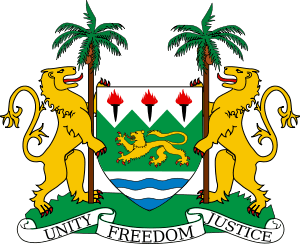Sierra Leone
 |
| |
| Use |
National flag, civil and state ensign |
| Proportion |
2:3 |
| Adopted |
27 April 1961 |
| Design |
A horizontal tricolour of light green, white and light blue |
 |
| Variant flag of Sierra Leone |
| Use |
Naval ensign |
| Proportion |
2:3 |
| Adopted |
27 April 1961 |
| Design |
White flag with the national flag in canton |
The flag of Sierra Leone is a tricolour consisting of three horizontal green, white and blue bands. It was adopted in 1961, Sierra Leone's independence year, to replace the British Blue Ensign defaced with the arms of the crown colony.
History
The British first arrived in what is now modern-day Sierra Leone in 1787, when philanthropists and abolitionists acquired 52 square kilometres (20 sq mi) of land situated close to Bunce Island for freed slaves. The site of the settlement is where Freetown is now located. It became a crown colony of the United Kingdom within its colonial empire in 1808.[1][2]
Under colonial rule, Sierra Leone used the British Blue Ensign and defaced it with the arms of the territory. The emblem of Sierra Leone at the time consisted of a circle depicting an elephant, an oil palm tree and mountains, along with the letters "S.L." standing for the initials of the territory's name. Other than the initials, the rest of the emblem's design was identical to the colonial arms of the Gold Coast, The Gambia and the Lagos Colony.[3] Sierra Leone was granted its own unique coat of arms in 1914, and the emblem on the Blue Ensign was modified to reflect this change.[3]
In 1960, the College of Arms formulated and then approved of a new flag and coat of arms for Sierra Leone, in anticipation of the colony's independence the following year. The arms was designed first, and its predominant colours of green, white, and blue were subsequently utilized towards the creation of the flag.[4] It was first hoisted at midnight on 27 April 1961, the day Sierra Leone became an independent country.[5] Two years later, the government passed a law making it illegal to "insult" the country's flag, along with the flags of "friendly" nations.[6]
Design
Symbolism
The colours of the flag carry cultural, political, and regional meanings. The green alludes to the country's natural resources[7] – specifically agriculture and its mountains.[3] – while the white epitomizes "unity and justice".[3][4][7] The blue evokes the "natural harbour" of Freetown, the capital city of Sierra Leone,[3][4] as well as the hope of "contributing to world peace" through its usage.[3]
Legal issues
The Sierra Leonean flag is utilized as a flag of convenience by foreign merchant vessels. The "minimum enforcement" of admiralty law on such vessels has led to illegal and suspicious activity.[8] This includes unlawful fishing,[8] as well as the usage of the flag on vessels from countries under United Nations sanctions.[9]
As a result, the Sierra Leonean government has taken measures to curtail registrations related to the practice of flag of convenience.[10] In 2010, they stopped allowing fishing vessels to register in order to stymie unauthorized catches within both its domestic waters and in international seas.[8] Two years later, they removed 10 ships from its registry believed to be from Iran. This followed the seizure of a ship in Lebanon that was carrying weapons for Syria and was purportedly flying the flag of Sierra Leone.[9]
Historical flags
| Flag | Duration | Use | Description |
.svg.png) | 1889–1914 | Flag of the Crown Colony of Sierra Leone | A British Blue Ensign defaced with the arms of the territory. Identical to the flags of the Gold Coast, The Gambia and the Lagos Colony except for the initials on the emblem. |
 | 1914–1961 | Flag of the Crown Colony of Sierra Leone | A British Blue Ensign defaced with the arms of the crown colony. This consisted of the old Union Jack at the middle chief,[upper-alpha 1] an oil palm tree at the sinister base, and an African person watching a ship arrive in the harbour. |
 | 1961-1971 | Personal Standard of Elizabeth II | |
.svg.png) | 1961-1971 | Standard of the Governor-General of Sierra Leone | |
Notes
References
- ↑ "Sierra Leone profile". BBC News (BBC). Retrieved June 10, 2014.
- ↑ "History of Sierra Leone". Lonely Planet. Retrieved June 10, 2014.
- 1 2 3 4 5 6 Smith, Whitney (October 30, 2013). "Flag of Sierra Leone". Encyclopedia Britannica. Encyclopedia Britannica, Inc. Retrieved June 10, 2014. (subscription required)
- 1 2 3 Kindersley, Dorling (November 3, 2008). Complete Flags of the World. Dorling Kindersley Ltd. p. 81. Retrieved June 10, 2014.
- ↑ Castell, Horace (April 27, 1961). "Thousands Cheer At Independence For Sierra Leone". Ottawa Citizen. Reuters. p. 1. Retrieved June 10, 2014.
- ↑ "Law Shields Flag". The Milwaukee Sentinel. Associated Press. April 24, 1963. p. 11. Retrieved June 10, 2014.
- 1 2 "Sierra Leone". The World Factbook. CIA. Retrieved June 10, 2014.
- 1 2 3 Akam, Simon (October 28, 2010). "Sierra ends flag of convenience for fishing vessels". Reuters. Retrieved June 18, 2014.
- 1 2 "Sierra Leone takes 10 Iranian ships off register". Associated Press. September 9, 2012. Retrieved June 18, 2014. (subscription required)
- ↑ Schlumberger, Charles E. (2010). Open Skies for Africa: Implementing the Yamoussoukro Decision. World Bank Publications. p. 132. Retrieved June 18, 2014.
External links
|
|---|
| | National flags | |
|---|
| | National coats of arms | |
|---|
|



.svg.png)


.svg.png)
